Reviews
Frank Leon by Giulio Blank, ArtNexus 1994
Frank Leon by Joahin Viietrick, Interview
Frank Leon by Klaus Steinmetz, 1993
Frank Leon
by Giulio V. Blanc
Art Nexus January-March 1994
Frank León's homage to the German artist Joseph Beuys and to Fernando Garcia, a visionary Cuban-American conceptual artist, is an example of the cross-fertilization that is occurring in the artistic melting pot of South Florida: the Cuban "generation of the 1980's," the Cuban-American "Miami generation," and contemporary U.S. and European art are coming together to the benefit of all.
Leon's performance and exhibition in October at ArtSpace/Virginia Miller Galleries in Coral Gables introduced Miami to an artist concerned with creativity as thought process, as ritual. Memory and ideas are essential to León and he successfully proves that something as ephemeral as conceptual art can be resurrected. Like a shaman, he puts the viewer in contact with the spirits of Beuys and Garcia, both deceased. Using the hare, hat, and mask, León makes constant reference to Beuys' performances. Beuys combined a complex symbolic idiom with raw, primal matter and energy. Art for him was magic, capable of transforming the mind and by extension reality. A survivor of a near-death experience as a soldier in World War II, he felt the need for rebirth in himself and in society. His urgent message was ultimately related to making his public conscious of the evils of war, racism, and environmental destruction.
Fernando Garcia was also concerned with art as it related to the surroundings of the artist and the viewers of his performances. Connections were established via long-distance telephone calls, earth excavations, hikes, maps, and calendars. His performances played with time and place. Like Beuys, he invited the viewer to think about his or her encounter with the surrounding landscape. One could not help but be intrigued, frustrated, and finally refreshed by this provocative challenge. In his prologue to the exhibition catalogue, Klaus Steinmetz notes, regarding León's interest in Beuys and Garcia, that he evolves into their message. He will be the memory so the doors of perception were not closed. It is indeed a memory trip for those of us who knew Garcia well. León's collages with their photos of the artist and his performances bring back the crystalline intellect of Garcia and the wonderful experience of witnessing him in action. |
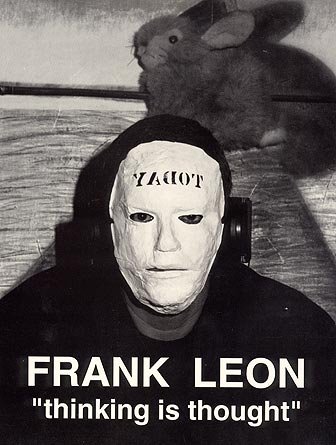 |
Invitation Cover |
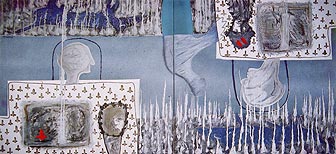 |
Frank Leon, Friedens-Coyote (diptic)
47 x 102 inches, 1993, Oil on Acrylic on Canvas |
|
top
The Problem of Exploring the Concept of Creativity in all its Directions
By: Joahin Viietrick
In a quiet house of Escscazu, in San Jose, Costa Rica, under the restless look of Noah, a small one-year-old child, this informal meeting between the famous Dutch critic and the artist took place. Only the provident tape recorder, hidden by the critic, allowed this conversation to become later the interview it is today.
Joahin Viietrick: Why Beuys and why Fernando Garcia?
Frank León: Because I esteem and admire both Beuys' and Fernando Garcia's work, outstanding as they are, each one within its context. Those are artistic lives cut short from the point of view of the logical sequence of time and space. Both of them should have lived as long as Picasso did, or even longer.
J.V.: But they're artists that have nothing in common. Neither in respect to the form, nor to the contents, nor generationally...
F L : Points of contact in art are very subtle. Sometimes references are just there and nobody sees them. But when you look into it, and explore and question, you start to find out elements that were not apparent in the first analysis.
J.V.: Conceptual or formal elements?
EL.: Well, conceptual elements, formal and vital elements, that sometimes are really important.
J.V.: Are you establishing a vital relationship between Beuys and Fernando Garcia?
FL.: Look, originally I was going to do an exhibition in honor of Beuys. But then I discovered Fernando's works and it got my attention. I started inquiring, interviewing people that knew him, and suddenly I came to realize he had been a magnificent artist, unfortunately barely known. I also noticed that there were points of contact between them in the way both took on their work. Both focused a great deal of their creation on performance and actions. As a Cuban, Fernando even anticipated the generation of the so called Cuban avant-garde of the '80s, because he had already done by that year some pieces of work worthy of respect. When the history of Cuban art after 1959 gets written, what was done in and outside Cuba should be included - otherwise it wouldn't be complete - and Fernando's work should have a prominent place. It's for all these reasons that I decided to dedicate the exhibition to both artists, to Beuys as an universal German, and to Fernando as a Cuban-American.
J.V.: Speaking of the Cuban avant-garde, the one known to be related to the '80s, do you belong to that avant-garde movement?
F.L.: Cuban reality in the '80s (including the '90s) is so postmodern and paradoxical that any generalization is a long way off the truth. I started painting when I was 18, in 1968, and had my first exhibition in 1980. My artistic development wasn't lineal. I worked in different fields, I studied several professions and majors. I don't come from the same background as that movement does, and it can be said that I was an autodidact until 1987, when I enrolled in the Higher Institute of Art (H.I.A.). In the '80s I connected myself with a group of friends belonging to that generation, among which were Arturo Cuenca, Consuelo Castaneda, Humberto Castro and others. My joining the H.I.A. was a decisive step, and it helped me to see the direction I was going to follow later. But my ways were different and I'm glad it was so.
In order to answer your question I would say that in my case I belong to the generation of the '90s, not of the '80s. I'm a member of that mass movement, unique in the history of art, that migrated to the U.S. at the beginning of the '90s, if this classification pleases your critic's ear.
J V : Is this movement considered a new Cuban avant-garde?
F.L.: For accuracy we'd have to analyze more deeply the so called generation of the '80s or Cuban avant-garde, etc.
|
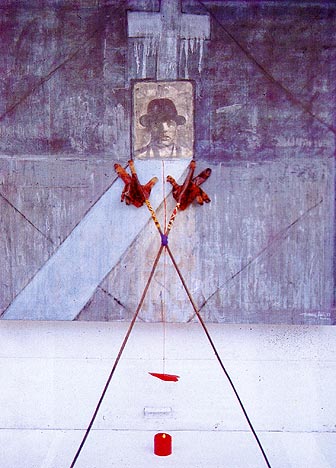 |
Frank Leon, Altar (Installation)
73 x 51 1/4 inches, 1993, Oil, Acrylic and Objects |
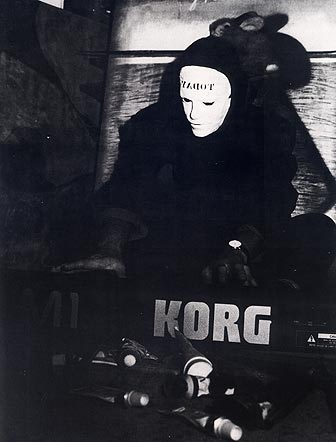 |
Still from Exhibition Performance |
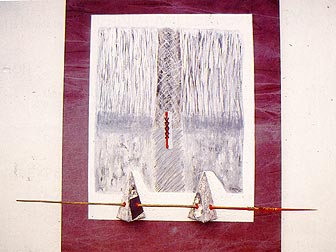 |
Frank Leon, Blood BH/2
47 x 39 1/4 inches, 1993, Oil, Acrylic and Objects on Canvas |
|
The group or generation I have mentioned was a heterogeneous one, and its members weren't precisely from the same generation. Since the first exhibition that lent its mark to the movement, in 1981, to the last one in 1990, there were insertions, desertions, enough shadows and lights as to not generalize. There are, as in any other movement, critics that get busy by advancing one group to the detriment of another. It is what Canclini calls the rite of egress. Sacralization of the pioneers' aesthetic audacity got tarnished if compared to what happened later, between 1985 and 1990, when the initiators of this course in the sleepy Cuban plastic art inserted themselves into the state mechanisms of promotion and were used by the political power as a demonstration of the system's abilities.
The breaking-off was revealed when the formal audacity of those pioneers came to be at variance with the thematic irreverence of their followers, who used the hegemonical aesthetics of the periphery and started questioning the conceptual-philosophical fundament of the status quo. This is in my opinion the true avant-garde movement in Cuba, one that didn't transcend adequately enough the way it should have, due to the hermetism of the Cuban system and the small attention the artists themselves paid to it.
I'm referring to those artists legitimized by the Government. Although some of the founders have said that they didn't make any concessions to the system, when praising the political images, the truth is that they neither made concessions to the colleagues' irreverence, and remained on the sidelines. They also tried not to deal with certain topics in their works, topics that would have put them in the political arena otherwise. They justified themselves by saying that they worked on more general subjects that had everlasting values, as if reflecting the present reality wouldn't be an everlasting value, which is one of art's functions in all times, by the way.
On the other hand the so-called aesthetic audacity that legitimizes them in and outside Cuba, doesn't come to be of any importance when this movement is extrapolated to U.S. What's more, by implanting themselves into the dominant and highly sterilized markets the so-called postmodernists, artists that exercised a very modern aesthetics in Cuba, get watered down in such a capitalistic and eclectic society, while in the look for other mechanisms of distinction and other symbolic-iconographic traditions.
If this is or not a new Cuban avant-garde, history and critics, the galleries, the market and the artists themselves will decide.
J.V.: History has several ways of being told...
F.L.: But the true one is written with all the interrelated elements...
J.V.: Truth has always two pencil leads...
EL.: And several erasers to rub it out...
J.V,: Okay, let's go back to your exhibition. You're going to have a performance on the opening day, and I believe you're going to play on a keyboard. Why that intention of getting off the visual subject and getting in contact with other arts? What does it contribute to your works at the reading level, etc.?
EL.: Look, Joahin, I'm a thinker, an analyzer of internal and external realities. One of my compasses is turned towards exploring the problem of creativity in all its directions. I consider that in art, as in science, one tends more and more to make the frontiers separating specialties disappear. The very concept of the artist has considerably changed in the last years. I intend to use all the resources of this developed society with the aim of elaborating and at the same time combining the different elements that appear independently in other respects. This way I intend to offer this as something more than a series of hanging pictures, so people could do more than looking at them and then leaving, which is already boring enough. I have my own way. I have neither style nor there's anything classing me as this or as that. I don't want to flirt with that or with this market, with that or this political trend. I just want to create. I had the opportunity of recreating the project with Virginia Miller, without any aesthetic ties or impositions. I've called this project "Thinking Is Thought," as a direct reference to the unity among thought, concept, idea and memory. All the paintings, including my performance, are full of referential allusions to the artists I'm honoring, without excluding their own conceptions.
J.V,: Any influences or affinities with artists or styles?
EL,: I really follow my own line ofthought when creating. I'm not going ahead of anybody, neither behind. I'm going at the pace of my own development, doing at every moment what I believe I should do. In the meantime I'm setting up my personal aesthetics, one that has to do a lot with my ethics.
As it is usual in these cases a question is made concerning future projects. Before you ask me let me tell you that I've got already my next project written down and worked out. And that I'm going to need a sponsor because I'll need a lot of equipment, so once the exhibition is over I'll start mailing the project to several institutions to ask for financial assistance.
top
Frank Leon
“Thinking Is Thought” an exhibition and opening perfomance
October 1-Nov. 3, 1993
Beuys, an Urgent Matter
by Klaus Steinmetz
San Jose de Costa Rica, August, 1993
It was not simple to understand that conceptualism was reaching a vitalistic poetry in its last stage.
Before being it already was: when the flirting between art and life was marred by modesty, by a romanticism that did not get its consummation in the flesh. Beuys spent the night with life, though. He kissed it on the eyelids at the time he was paradoxically at death's door. (We know about the tools of his passion, the anecdote of felt and grease, of honey, of the hat's reasons...) As he insisted on living, he had to learn the words again, the meaning of the world. It was then he thought that living was art. Since then we have artists peeling onions and sweeping streets. Not because of those simple deeds, but because of the attitudes. We are all artists in the making. The same way we all are alive, in the making.
The subject had transcended on behalf of plastic art, and that subject would not have to exhaust itself (what assured the permanence of Duchamp's revolution). The validity of virtual time was being questioned for both the scenic and performance arts. Eternity had been ritualized.
For he was our shaman and we were the push of a new spirituality, regained in the middle of the street, while in the strident retort of daily events. Similarly, and by means of a dialectical process, by means of a generating symbiosis, the artist influenced and transformed all strata of human life. Society could and should have bowed to the conditions of creativity. It was the "social plastic art."
It was not simple to understand that conceptualism was reaching a vitalistic poetry in its last stage.
Here western-like rationalism was not able to see clearly either.
It was preferable to explain art to a dead rabbit.
Other artists, out of necessity for a new language, achieved that cathartic approximation to the subject. They were able to understand the higher channels of their symbols and experience, being as they were after a piece of space that made possible their reasoning as one of freedom.
Fernando Garcia reached that point. He wove Ariadne's thread, combining the militant worries of the German plastic scene in the ’70s with the problematics of his island, of his ever imponderable island... He discovered his own honey, his own grease, his own rabbit.
He will be the memory, “so the doors of perception were not closed."
Frank León does not try to attain as much. He would rather summon them. He executes a great paraphrase, and have them talk with his hands, on behalf of remembrance, avoiding the inevitable melancholy and melodrama. He explains himself through them, using their icons, and bringing them to a present and to a context in which they would look inaccessible. He does not become one of them, but evolves into their messenger. He will be the memory, “so the doors of perception were not closed.”
top
|
